 Buick Enclave: Tire Changing
Buick Enclave: Tire Changing
Removing Tools
The tools needed to remove the spare tire are located in the storage compartment on the driver side, at the rear of the vehicle.
1. Open the jack storage compartment by pulling on the latch tab, located toward the rear of the vehicle, and pulling the cover off.
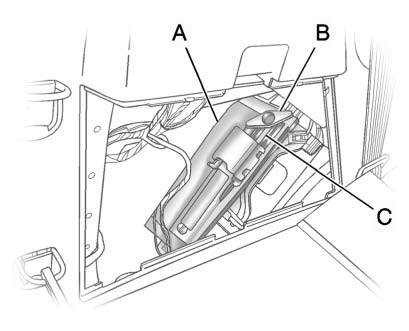
A. Tool Bag
B. Wing Bolt
C. Jack
2. Remove the wing bolt (B) by turning it counterclockwise.
3. Push the jack (C) up out of the holding bracket and remove the tool bag (A).
4. Turn the jack on its side, with the bottom facing toward you.
5. Pull the jack straight out, bottom first.
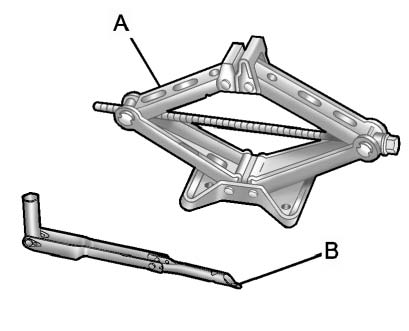
A. Jack
B. Wrench (Three-Piece Shown, One-Piece Similar)
The tools you will be using include the jack (A) and wrench (B).
Removing the Spare Tire
The compact spare tire is located under the vehicle, in front of the rear bumper. See Compact Spare Tire for more information.
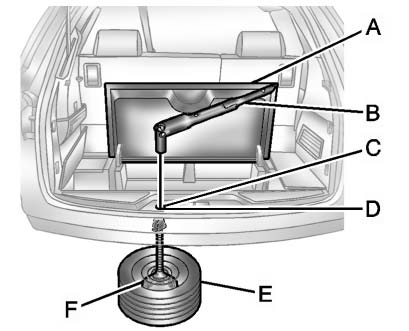
A. Rear Convenience Center
B. Wrench (Three-Piece Shown, One-Piece Similar)
C. Carpet Cutout
D. Hoist Shaft
E. Compact Spare Tire
F. Retainer
1. Open the storage compartment door of the convenience center (A) that is nearest
the liftgate.
2. Open the carpet cutout (C) that is located through the hole of the storage compartment.
3. Attach the wrench (B) into the hoist shaft (D).
4. Turn the wrench (B) counterclockwise to lower the spare tire (E) to the ground.
Continue turning the wrench until the spare tire can be pulled out from under the vehicle.
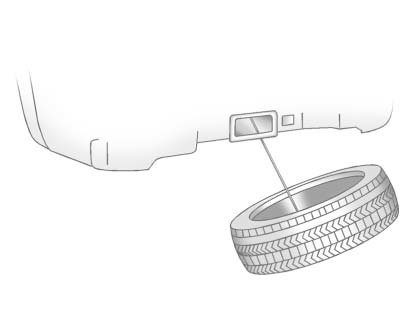
5. Tilt the retainer and slip it through the wheel opening to remove the spare tire from the cable.
6. Turn the wrench clockwise to raise the cable back up after removing the spare tire.
Do not store a full-size or a flat road tire under the vehicle.
See “Storing the Spare Tire” and “Storing the Flat Tire” later in this section.
Removing the Flat Tire and Installing the Spare Tire 1. Do a safety check before proceeding. See If a Tire Goes Flat for more information.
2. If the vehicle has a wheel cover, loosen the plastic nut caps with the wheel wrench. They will not come off. Then, using the flat end of the wheel wrench, pry along the edge of the cover until it comes off. Be careful; the edges may be sharp. Do not try to remove the cover with your bare hands.
Store the wheel cover securely in the rear of the vehicle until you have the flat tire repaired or replaced.
If the vehicle has aluminum wheels, remove the wheel nut caps using the wheel wrench.
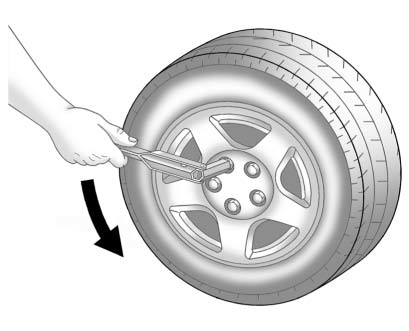
3. Loosen the wheel nuts — but do not remove them — using the wrench. For wheels with a wheel lock key, use the wheel lock key between the lock nut and wrench. The key is supplied in the front passenger door pocket.
Notice: If this vehicle has wheel locks and an impact wrench is used to remove the wheel nuts, the lock nut or wheel lock key could be damaged. Do not use an impact wrench to remove the wheel nuts if this vehicle has wheel locks.
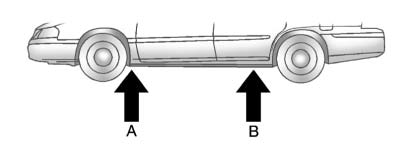
4. To identify the appropriate jacking location, find the triangle (A) about 30.5 cm (12 in) from the front tire or (B) about 27 cm (10.5 in) from the rear tire.
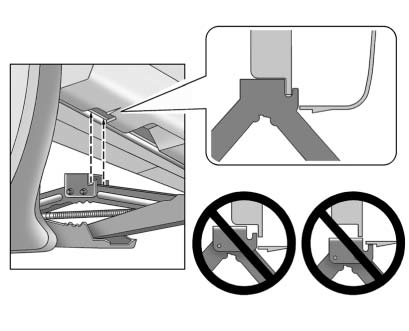
The triangle is located near each wheel on the vehicle's exterior.
Notice: If a jack is used to raise the vehicle without positioning it correctly, the vehicle could be damaged. When raising the vehicle on a jack, avoid contact with the rear axle control arms.
5. Attach the wrench to the jack, and turn the wrench clockwise to raise the
jack head 7.6 cm (3 in).
6. Do not raise the vehicle yet.
Put the compact spare tire near you
 WARNING
WARNING
Getting under a vehicle when it is jacked up is dangerous. If the vehicle slips
off the jack, you could be badly injured or killed.
Never get under a vehicle when it is supported only by a jack.
 WARNING
WARNING
Raising the vehicle with the jack improperly positioned can damage the vehicle
and even make the vehicle fall. To help avoid personal injury and vehicle damage,
be sure to fit the jack lift head into the proper location before raising the vehicle.
7. Raise the vehicle by turning the wrench clockwise in the jack.
Raise the vehicle far enough off the ground so that there is enough room for the spare tire to fit under the wheel well.
8. Remove all the wheel nuts and the flat tire.
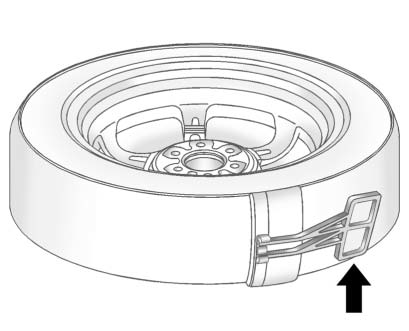
9. Remove the plastic spare tire heat shield by pulling the rubber latch. Store the plastic spare tire heat shield. See “Storing the Spare Tire” later in this section for more information.
 WARNING
WARNING
Rust or dirt on a wheel, or on the parts to which it is fastened, can make wheel
nuts become loose after time. The wheel could come off and cause an accident. When
changing a wheel, remove any rust or dirt from places where the wheel attaches to
the vehicle.
In an emergency, a cloth or a paper towel can be used; however, use a scraper or wire brush later to remove all rust or dirt.
 WARNING
WARNING
Never use oil or grease on bolts or nuts because the nuts might come loose. The
vehicle's wheel could fall off, causing a crash.
10. Remove any rust or dirt from the wheel bolts, mounting surfaces, and spare
wheel.
11. Place the spare tire on the wheel mounting surface.
12. Put the nuts on by hand by turning them clockwise until the wheel is held against
the mounting surface. Make sure the rounded end is toward the wheel.
13. Lower the vehicle by attaching the wrench to the jack and turning the wrench
counterclockwise. Lower the jack completely.
 WARNING
WARNING
Wheel nuts that are improperly or incorrectly tightened can cause the wheels
to become loose or come off. The wheel nuts should be tightened with a torque wrench
to the proper torque specification after replacing. Follow the torque specification
supplied by the aftermarket manufacturer when using accessory locking wheel nuts.
See Capacities and Specifications for original equipment wheel nut torque
specifications.
Notice: Improperly tightened wheel nuts can lead to brake pulsation and rotor damage.
To avoid expensive brake repairs, evenly tighten the wheel nuts in the proper sequence and to the proper torque specification.
See Capacities and Specifications for the wheel nut torque specification.
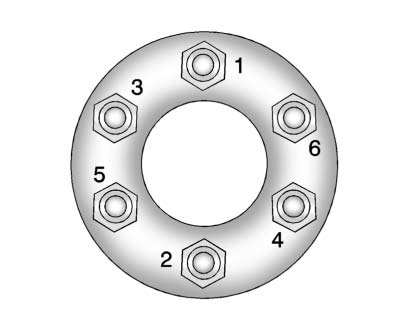
14. Tighten the wheel nuts firmly in a crisscross sequence, as shown.
Notice: Wheel covers will not fit on the vehicle's compact spare.
If you try to put a wheel cover on the compact spare, the cover or the spare could be damaged.
Storing the Spare Tire
 WARNING
WARNING
The underbody-mounted spare tire needs to be stored with the valve stem pointing
down.
If the spare tire is stored with the valve stem pointing upwards, the secondary latch will not work properly and the spare tire could loosen and suddenly fall from the vehicle. If this happened when the vehicle was being driven, the tire might contact a person or another vehicle, causing injury and damage to itself. Be sure the underbody-mounted spare tire is stored with the valve stem pointing down.
 WARNING
WARNING
Storing a jack, a tire, or other equipment in the passenger compartment of the
vehicle could cause injury. In a sudden stop or collision, loose equipment could
strike someone. Store all these in the proper place.
To store the spare tire:
1. Lay the compact spare tire near the rear of the vehicle with the valve stem
down.
2. Reinstall the plastic spare tire heat shield on the compact spare tire.
3. Slide the cable retainer through the center of the wheel and start to raise the
compact spare tire.
Make sure the retainer is fully seated across the underside of the wheel.
4. When the compact spare tire is almost in the stored position, turn the tire so the valve is toward the rear of the vehicle.
This position helps when checking the air pressure in the compact spare tire.
5. Raise the tire fully against the underside of the vehicle.
Continue turning the wrench until you feel more than two clicks.
This indicates that the compact spare tire is secure and the cable is tight. The spare tire hoist cannot be overtightened.
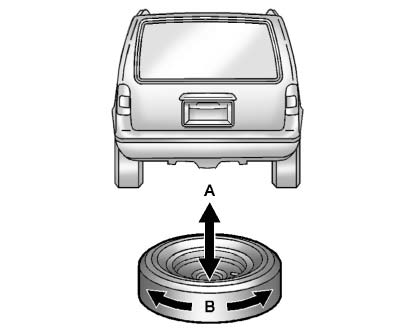
6. Make sure the tire is stored securely. Push, pull (A), and then try to turn (B) the tire. If the tire moves, use the wrench to tighten the cable.
Storing the Flat Tire
1. Remove the cable package from the jack storage area.
2. Remove the small center cap by tapping the back of the cap with the extension
of the shaft, if the vehicle has aluminum wheels.
3. Put the flat tire in the rear storage area with the valve stem pointing toward
the rear of the vehicle.
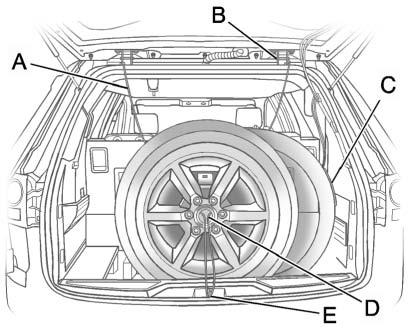
A. Cable
B. Liftgate Hinges
C. Spare Tire Heat Shield
D. Center of the Wheel
E. Door Striker
4. Pull the cable (A) through the door striker (E), the center of the wheel (D), and the plastic spare tire heat shield (C), as shown.
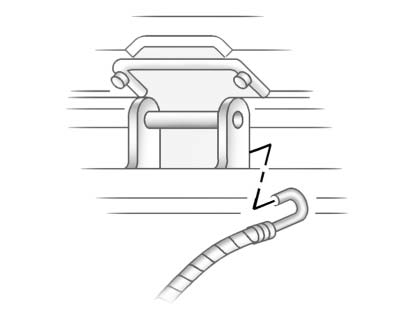
5. Hook the cable onto the outside portion of the liftgate hinges (B).
6. Hook the other end of the cable onto the outside portion of the liftgate hinge
on the other side of the vehicle.
7. Pull on the cable to make sure it is secure.
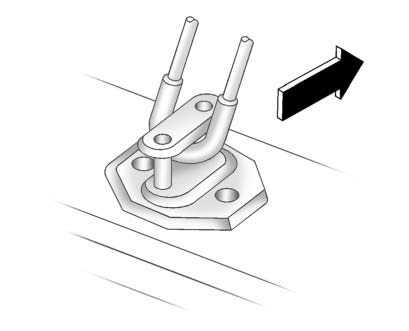
8. Make sure the metal tube is centered at the striker. Push the tube toward
the front of the vehicle.
9. Close the liftgate and make sure it is latched properly.
Storing the Tools
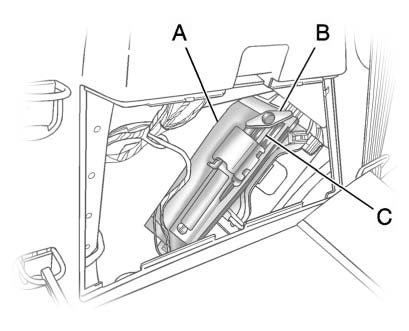
A. Tool Bag
B. Wing Bolt
C. Jack
Put back all tools as they were stored in the jack storage compartment and put the compartment cover back on.
1. Ensure that the bottom of the jack is facing toward you.
2. Replace the tool bag (A).
3. Turn the jack (C) on its side and place down on the holding bracket.
4. Reinstall the wing bolt (B) by turning clockwise.
5. To replace the cover, line up the tab at the front of the cover with the notch
in the cover opening.
Push the cover in place and make sure that the rear clips are in the slots and push the cover closed.
Store the center cap or the plastic bolt-on wheel covers until a full size tire is put back on the vehicle. When you replace the compact spare with a full-size tire, reinstall the bolt-on wheel covers or the center cap.
Hand-tighten them over the wheel nuts, using the wrench.
 Storing the Tire Sealant and Compressor Kit
Storing the Tire Sealant and Compressor Kit
The tire sealant and compressor kit is located in the storage compartment on
the driver side, at the rear of the vehicle.
1. Press down on the latch tab and pull the cover off to access the stora ...
 Compact Spare Tire
Compact Spare Tire
WARNING
Driving with more than one compact spare tire at a time could result in loss
of braking and handling. This could lead to a crash and you or others could be injured.
Use only one compact s ...
See also:
Engine compartment
CAUTION
Never use a fuse of a higher or lower
amperage rating than that specified on the
fuse box cover. This could damage the
electrical system or cause a fire.
If any electrical equipme ...
Map Adjustments
The system lets you adjust the scale of view on the map. Also, as you drive,
the map scrolls automatically based on the direction of travel. ...
Replacement tires
Always fit replacement tires of the same type, and wherever possible, of the
same make and tread pattern.
If the use of tires not recommended by Land Rover is unavoidable, ensure that
you read, a ...






